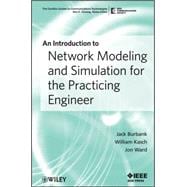
What is included with this book?
| Preface | p. vii |
| Acknowledgments | p. ix |
| About the Authors | p. xi |
| Introduction | p. 1 |
| Advantages and Disadvantages of Modeling and Simulation | p. 6 |
| Comparison of "Homebrew" Models and Simulation Tools | p. 8 |
| Common Pitfalls of Modeling and Simulation and Rules of Thumb | p. 9 |
| An Overview of Common M&S Tools | p. 16 |
| An Overview of the Rest of This Book | p. 18 |
| Modeling and Simulation for RF Propagation | p. 20 |
| The Fading Channel | p. 22 |
| The ITU M.1225 Multipath Fading Profile for Mobile WiMAX | p. 38 |
| Practical Fading Model Implementations-WiMAX Example | p. 42 |
| RF Propagation Simulators | p. 45 |
| Propagation and Fading Simulations-Lessons Learned | p. 48 |
| Physical Layer Modeling and Simulation | p. 51 |
| Incorporating Interference into a Model | p. 52 |
| The Importance of a Preamble | p. 59 |
| Practical Wireless PHY Model Implementations | p. 62 |
| Wireless Network Simulation Lessons Learned and Common Pitfalls-PHY Layer | p. 69 |
| Medium Access Control Modeling and Simulation | p. 72 |
| Modeling and Simulation of Wired MACs | p. 73 |
| Wireless Network MAC Simulation | p. 78 |
| Practical MAC Model Implementations | p. 90 |
| Network Simulation Lessons Learned and Common Pitfalls-MAC Layer | p. 92 |
| Modeling and Simulation for Higher Layer Protocols | p. 97 |
| Network Layer | p. 97 |
| Transport and Application Layers | p. 102 |
| Example of Higher Layer Modeling: Transport Layer Performance Analysis | p. 105 |
| Example of Higher Layer Modeling: Detailed Network Layer Modeling | p. 109 |
| Hardware-in-the-Loop Simulations | p. 114 |
| Advantages and Disadvantages of HITL Approaches | p. 118 |
| Network M&S HITL Approaches | p. 120 |
| HITL Examples | p. 126 |
| Common Pitfalls for HITL Approaches | p. 139 |
| Network-Layer HITL-Ready Network Simulation Platforms | p. 139 |
| HITL Conclusion | p. 142 |
| Complete Network Modeling and Simulation | p. 143 |
| Complete Network M&S Platforms | p. 145 |
| IEEE HLA (1516) | p. 145 |
| Complete Network Simulation Examples | p. 172 |
| Other Vital Aspects of Successful Network Modeling and Simulation | p. 180 |
| Verification and Validation | p. 180 |
| Data Visualization and Interpretation | p. 185 |
| Network Modeling and Simulation: Summary | p. 186 |
| References | p. 188 |
| Index | p. 196 |
| Table of Contents provided by Ingram. All Rights Reserved. |
The New copy of this book will include any supplemental materials advertised. Please check the title of the book to determine if it should include any access cards, study guides, lab manuals, CDs, etc.
The Used, Rental and eBook copies of this book are not guaranteed to include any supplemental materials. Typically, only the book itself is included. This is true even if the title states it includes any access cards, study guides, lab manuals, CDs, etc.